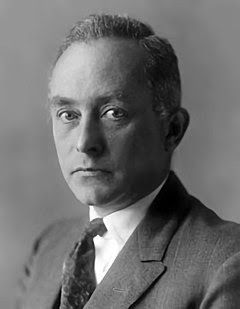Max Born - Wiki | Nobel Prize | Quotes | Biography | Books | Atomic Physics
Max Born - Wiki | Nobel Prize | Quotes | Biography | Books | Atomic Physics
Max Born born on (11th December,1882 – 5 January 1970) was a German physicist and mathematician who was instrumental in the development of quantum mechanics. He also made contributions to solid-state physics, optics and supervised the work of a number of notable physicists in the 1920s and 1930s. Max Born won the 1954 Nobel Prize in Physics for his "fundamental research in Quantum Mechanics, especially in the statistical interpretation of the wave function".
His Residence in Gottingen, West Germany and his citizenship of German, British. His Alma Mater of University of Gottingen. He was known for Born-Haber cycle, Born rigidity, Born coordinates, Born approximation, Born probability, Born-Infeld theory, Born Oppenheimer approximation, Born's rule, Born-Lande equation, Born-Huang approximation, Born-von Karman boundary condition, Born equation. His Spouse name Hedwig (Hedi) Ehrenberg (1892-1972). Max Born have two daughter's and one son. He is in the field of Theoritical physics.
Max Born Awards
Atomic Physics
Max Born Books
1. Problem of Atomic Dynamics (1960).
2. Experiment and Theory in Physics (1943).
3. Atomic Physics (1944).
4. Natural Philosophy of Cause and Chance (1949).
5. The Restless Universe (1951).
6. Dynamical Theory of Crystal Lattices (1954).
7. Principles of Optics (1959).
8. Problems of Atomic Dynamics (1960).
9. Einstein Theory of Relatively (1962).
10. Physics in My Generation (1968).
11. The Born-Einstein Letters (1971).
Max Born Quotes
 |
| Max Born |
His Residence in Gottingen, West Germany and his citizenship of German, British. His Alma Mater of University of Gottingen. He was known for Born-Haber cycle, Born rigidity, Born coordinates, Born approximation, Born probability, Born-Infeld theory, Born Oppenheimer approximation, Born's rule, Born-Lande equation, Born-Huang approximation, Born-von Karman boundary condition, Born equation. His Spouse name Hedwig (Hedi) Ehrenberg (1892-1972). Max Born have two daughter's and one son. He is in the field of Theoritical physics.
Max Born Awards
Nobel Prize in Physics (1954)Hughes Medal (1950)Max Planck Medal (1948)Fellow of the Royal Society (1939)
Atomic Physics
In 1925, Born and Heisenberg formulated the matrix mechanics representation of quantum mechanics. On 9 July, Heisenberg gave Born a paper entitled Über quantentheoretische Umdeutung kinematischer und mechanischer Beziehungen ("Quantum-Theoretical Re-interpretation of Kinematic and Mechanical Relations") to review, and submit for publication. In the paper, Heisenberg formulated quantum theory, avoiding the concrete, but unobservable, representations of electron orbits by using parameters such as transition probabilities for quantum jumps, which necessitated using two indexes corresponding to the initial and final states. When Born read the paper, he recognized the formulation as one which could be transcribed and extended to the systematic language of matrices, which he had learned from his study under Jakob Rosanes at Breslau University.
Up until this time, matrices were seldom used by physicists; they were considered to belong to the realm of pure mathematics. Gustav Mie had used them in a paper on electrodynamics in 1912 and Born had used them in his work on the lattices theory of crystals in 1921. While matrices were used in these cases, the algebra of matrices with their multiplication did not enter the picture as they did in the matrix formulation of quantum mechanics. With the help of his assistant and former student Pascual Jordan, Born began immediately to make a transcription and extension, and they submitted their results for publication; the paper was received for publication just 60 days after Heisenberg's paper. A follow-on paper was submitted for publication before the end of the year by all three authors. The result was a surprising formulation:
where p and q were matrices for location and momentum, and I is the identity matrix. Note that the left hand side of the equation is not zero because matrix multiplication is not commutative. This formulation was entirely attributable to Born, who also established that all the elements not on the diagonal of the matrix were zero. Born considered that his paper with Jordan contained "the most important principles of quantum mechanics including its extension to electrodynamics." The paper put Heisenberg's approach on a solid mathematical basis.
Max Born Books
1. Problem of Atomic Dynamics (1960).
2. Experiment and Theory in Physics (1943).
3. Atomic Physics (1944).
4. Natural Philosophy of Cause and Chance (1949).
5. The Restless Universe (1951).
6. Dynamical Theory of Crystal Lattices (1954).
7. Principles of Optics (1959).
8. Problems of Atomic Dynamics (1960).
9. Einstein Theory of Relatively (1962).
10. Physics in My Generation (1968).
11. The Born-Einstein Letters (1971).
Max Born Quotes
"The belief that there is only one truth, and that oneself is in possession of it, is the root of all evil in the world"
"I am now convinced that theoretical physics is actually philosophy"
"Intellect distinguishes between the possible and the impossible; reason distinguishes between the sensible and the senseless. Even the possible can be senseless"




Comments
Post a Comment